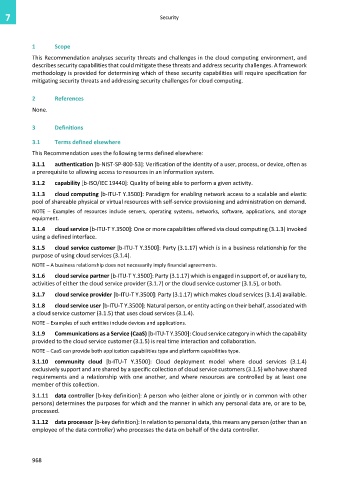Page 976 - Cloud computing: From paradigm to operation
P. 976
7 Security
1 Scope
This Recommendation analyses security threats and challenges in the cloud computing environment, and
describes security capabilities that could mitigate these threats and address security challenges. A framework
methodology is provided for determining which of these security capabilities will require specification for
mitigating security threats and addressing security challenges for cloud computing.
2 References
None.
3 Definitions
3.1 Terms defined elsewhere
This Recommendation uses the following terms defined elsewhere:
3.1.1 authentication [b-NIST-SP-800-53]: Verification of the identity of a user, process, or device, often as
a prerequisite to allowing access to resources in an information system.
3.1.2 capability [b-ISO/IEC 19440]: Quality of being able to perform a given activity.
3.1.3 cloud computing [b-ITU-T Y.3500]: Paradigm for enabling network access to a scalable and elastic
pool of shareable physical or virtual resources with self-service provisioning and administration on demand.
NOTE – Examples of resources include servers, operating systems, networks, software, applications, and storage
equipment.
3.1.4 cloud service [b-ITU-T Y.3500]: One or more capabilities offered via cloud computing (3.1.3) invoked
using a defined interface.
3.1.5 cloud service customer [b-ITU-T Y.3500]: Party (3.1.17) which is in a business relationship for the
purpose of using cloud services (3.1.4).
NOTE – A business relationship does not necessarily imply financial agreements.
3.1.6 cloud service partner [b-ITU-T Y.3500]: Party (3.1.17) which is engaged in support of, or auxiliary to,
activities of either the cloud service provider (3.1.7) or the cloud service customer (3.1.5), or both.
3.1.7 cloud service provider [b-ITU-T Y.3500]: Party (3.1.17) which makes cloud services (3.1.4) available.
3.1.8 cloud service user [b-ITU-T Y.3500]: Natural person, or entity acting on their behalf, associated with
a cloud service customer (3.1.5) that uses cloud services (3.1.4).
NOTE – Examples of such entities include devices and applications.
3.1.9 Communications as a Service (CaaS) [b-ITU-T Y.3500]: Cloud service category in which the capability
provided to the cloud service customer (3.1.5) is real time interaction and collaboration.
NOTE – CaaS can provide both application capabilities type and platform capabilities type.
3.1.10 community cloud [b-ITU-T Y.3500]: Cloud deployment model where cloud services (3.1.4)
exclusively support and are shared by a specific collection of cloud service customers (3.1.5) who have shared
requirements and a relationship with one another, and where resources are controlled by at least one
member of this collection.
3.1.11 data controller [b-key definition]: A person who (either alone or jointly or in common with other
persons) determines the purposes for which and the manner in which any personal data are, or are to be,
processed.
3.1.12 data processor [b-key definition]: In relation to personal data, this means any person (other than an
employee of the data controller) who processes the data on behalf of the data controller.
968

